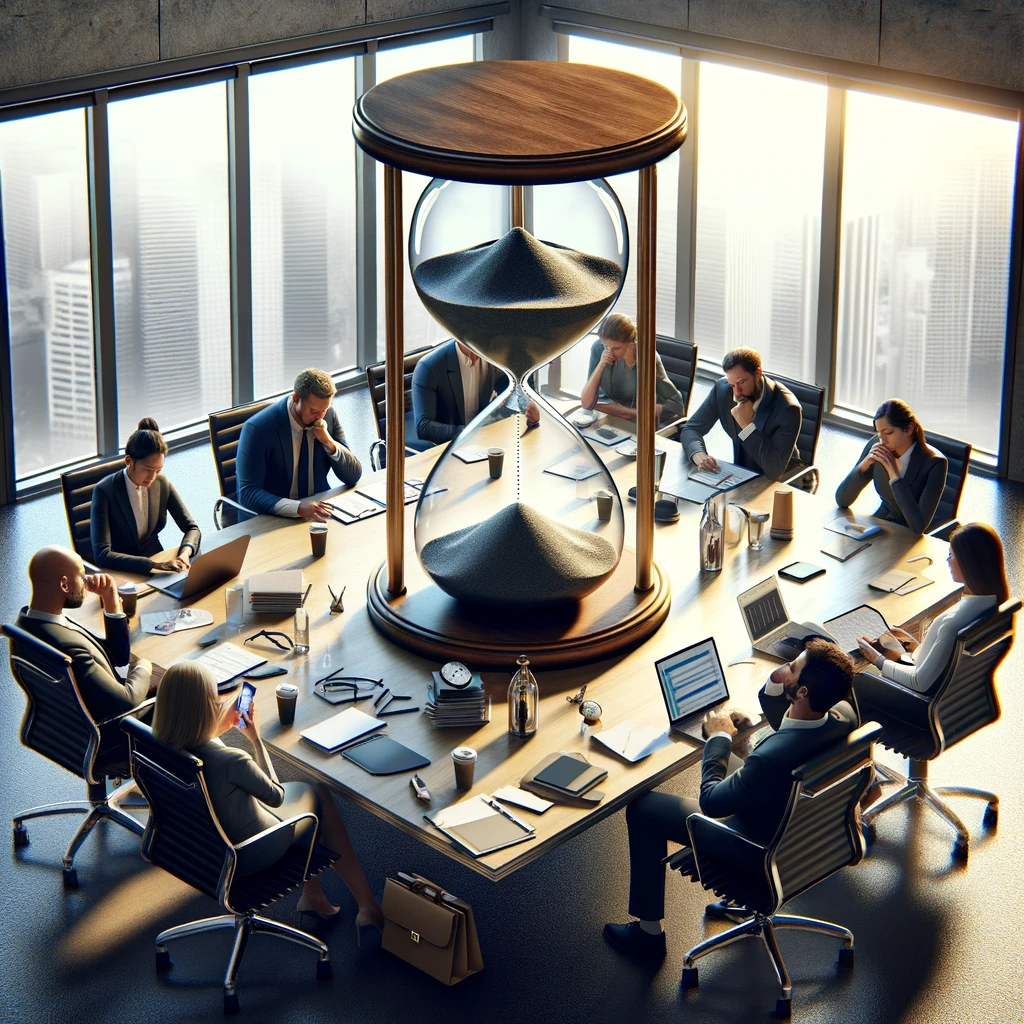Early in my career, I spent an average of five hours per week in meetings, most lasting around 40 minutes. However, reflecting on this, many of these meetings could have been shorter or replaced with an email. This realization mirrors findings from Harvard Business Review, which reveal companies spend a total of $37 billion per year on meetings!
The cost of meetings isn't just financial. It also encompasses the loss of time, energy, and creativity. Large organizations may waste up to $100 million per year on unnecessary meetings. Smaller companies, with around 100 employees, could save approximately $2.5 million annually by reducing needless meetings.
The financial aspect is significant, but the broader impact on workplace efficiency is even more critical. Meetings are essential for collaboration and decision-making, but they also have the potential to be inefficient. Recognizing and addressing this inefficiency is key to improving workplace productivity.
I will explore the reasons behind the failure of many meetings, propose strategies for making them more effective, and discuss how improved meeting management can impress leadership and benefit the entire organization.
The True Cost of Meetings

Financial Impact
The financial toll of inefficient meetings is more substantial than it appears at first glance. In large corporations, the annual loss can reach up to $100 million. For smaller companies, particularly those with about 100 employees, cutting down on unnecessary meetings could save around $2.5 million per year. These figures are not just hypothetical but are based on real-world data and studies. They highlight a critical area of potential cost-saving that often goes unnoticed in budget reviews.
Impact Beyond Money
The true cost of meetings extends beyond just financial losses. It includes the loss of time - a resource that, once spent, cannot be recovered. An average employee spends a significant portion of their workweek in meetings, many of which might be unnecessary. This time could be better spent on productive tasks, creative endeavours, or even rest, leading to improved overall well-being and job satisfaction.
Moreover, the energy and creativity drain caused by excessive meetings cannot be understated. Engaging in unproductive meetings can leave employees feeling fatigued and uninspired. This can have a domino effect on their work, dampening innovation and reducing the quality of output.
Case Studies and Examples
To put this into perspective, let's consider a few examples. In some organizations, meetings are convened to discuss topics that could have been effectively communicated via email or a brief memo. In others, routine status updates consume time that could be used for strategic planning or skill development. These scenarios are not uncommon and signify a larger trend of meeting mismanagement in the workplace.
Let this sink in.
The Potential Time Waste of Meetings

Importance of Meetings
Meetings are indispensable for collaboration, decision-making, and communication in the workplace. However, not every meeting is necessary or productive. Identifying and eliminating meetings that don't add value is crucial for efficient time management.
Insights from Adam Grant
Adam Grant, in his TED Talk "WorkLife," discusses the inefficiencies often found in modern meetings. He points out that many meetings are held for matters that have little bearing on work productivity, such as discussing minor technical settings or personal preferences. These types of meetings contribute little to organizational goals and can often be avoided.
Examples of Inefficient Meetings
For instance, meetings convened to discuss trivial topics like Zoom settings or favourite pizza toppings are clear examples of inefficient use of time. While these discussions might be well-intentioned for team bonding, they often do not justify the time spent, especially when they become routine or lengthy.
Perspective of Organizational Psychologists
Organizational psychologists like Steven Rogelberg suggest that meetings often fail to realize human potential and can be counterproductive. Humorist Dave Barry echoes this sentiment, humorously critiquing how meetings can turn into time-wasting exercises.
Real-Life Implications
In practice, this means that a 30-minute reduction in a meeting with 20 people can save a collective 10 hours. This time could be redirected towards more productive activities, directly impacting organizational efficiency and employee satisfaction.
Why Meetings Fail
Root Causes of Meeting Inefficiency
The inefficiency of many meetings can often be traced back to their purpose and execution. According to organizational psychologist Steven Rogelberg, about a third of all meetings are deemed unnecessary. This high percentage indicates a systemic issue within workplace culture where meetings are scheduled as a default, rather than as a strategic tool.
The Impact Beyond Time Loss
Meetings that are poorly planned and executed not only waste time but also have broader implications. They can sap creativity, leaving attendees feeling drained and less capable of contributing effectively to their work. Furthermore, the stress and frustration associated with unproductive meetings can affect employee morale and mental health.
Execution and Purpose
A key factor in meeting failure is a lack of clear purpose. Meetings without a specific goal tend to meander and lose focus, resulting in unproductive time spent. Additionally, poor execution, such as a lack of agenda or ineffective moderation, can derail even the most well-intentioned meetings.
Strategies for Improvement
Understanding why meetings fail is the first step towards improving them. By focusing on clear objectives, precise agendas, and effective facilitation, many of the common pitfalls can be avoided. This requires a shift in how meetings are perceived and approached within the organization.
Strategies to Transform Meetings

Redefining Meeting Necessity
Before scheduling a meeting, it's essential to assess whether it's truly needed. Ask if the meeting's purpose is for decision-making, learning, bonding, or action. If the objective can be achieved through an email or asynchronous communication, choose those options instead. This step helps to filter out meetings that do not add significant value.
Optimizing Meeting Length and Format
Challenge the standard 30-minute or hour-long meeting format. Experiment with shorter meetings, like focused 15-minute sessions or stand-up meetings, to keep discussions concise and on-point. This approach can lead to more efficient use of time and prevent unnecessary prolongation of discussions.
Curating Attendees
Carefully consider who needs to be in the meeting. Invite only those with relevant expertise or decision-making authority. Over-inviting can lead to bloated, ineffective meetings. A policy like Microsoft Japan’s, which limits meetings to five attendees unless specially approved, can be a useful guideline.
Revamping the Agenda
Transform the agenda from a list of topics to a set of questions that need answers. This shift encourages attendees to think critically about the issues at hand and to come prepared with ideas, enhancing engagement and productivity.
Promoting Active Participation
Encourage diverse contributions by framing agendas as questions and rotating meeting leadership among team members. This approach fosters a more inclusive environment where all attendees feel valued and are more likely to contribute actively.
Case Study: Microsoft Japan
Microsoft Japan experimented with a '4-day work week' and found that shorter meetings led to a significant increase in productivity. By limiting meeting times and attendees, they demonstrated that efficient meetings could contribute to a better work-life balance and higher overall productivity.
Impress Your Boss with Meeting Efficiency

Implementing effective meeting strategies is not only beneficial for productivity but also an opportunity to demonstrate leadership and foresight.
Here's how you can impress your boss and make a positive impact on your team and organization:
Showcasing Leadership
By advocating for more efficient meetings, you position yourself as a proactive leader. This involves not just suggesting improvements but also taking the initiative to implement them. For example, if you're leading a meeting, try applying the strategies discussed earlier, such as a focused agenda and a curated attendee list. Your ability to run efficient meetings can set a standard for others to follow.
Demonstrating Time and Cost Savings
Efficient meetings can lead to significant time and cost savings. Presenting these benefits to your boss can be a powerful way to showcase the impact of your initiatives. For instance, calculate the time saved by reducing the length of meetings and show how this extra time has been reallocated to productive tasks. This tangible demonstration of efficiency can be very persuasive.
Enhancing Team Productivity and Engagement
An immediate benefit of efficient meetings is the improvement in team productivity and engagement. When meetings are concise, focused, and involve the right people, team members are more likely to be engaged and contribute effectively. This can lead to faster decision-making, more innovative ideas, and a more dynamic work environment, which are all likely to be noticed and appreciated by your boss.
Personal Initiative
Taking the initiative to evaluate and improve meetings in your organization shows a commitment to continuous improvement. It reflects your dedication to not just your personal growth but also to the betterment of the team and organization.
Conclusion
In reflecting on my early career experiences with frequent and often lengthy meetings, I've come to appreciate the profound impact that efficient meeting management can have on both personal productivity and organizational success. This journey from realization to action embodies a shift towards a more mindful and purpose-driven approach to workplace collaboration.
The financial and time savings from reducing unnecessary meetings are substantial, but the benefits extend far beyond these tangible measures. By fostering a culture of efficient meetings, we can unleash the full creative and innovative potential of our teams, enhancing job satisfaction and overall workplace morale.
As we've explored, transforming meetings isn't just about cutting down their length or frequency. It's about rethinking their purpose, ensuring active participation, and continually seeking improvements. The strategies discussed are not exhaustive, but they offer a solid foundation for anyone looking to make a meaningful change in their approach to meetings.
I encourage you to start evaluating your meetings with a critical eye. Are they necessary? Are they efficient? Are they engaging? Implement these changes gradually and observe the positive impact on your work life and the impression you make on your peers and leaders.
